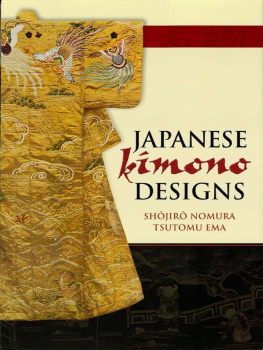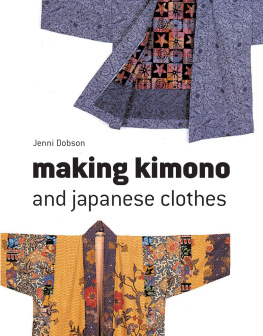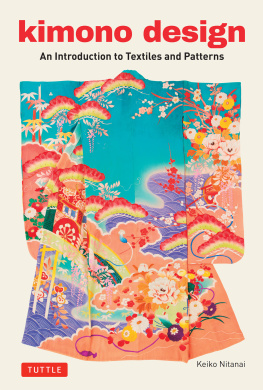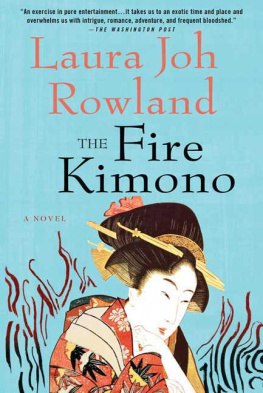Knit
Kimono
Too
simple designs
to mix, match + layer
VICKI SQUARE

Acknowledgments
For all who knit for beauty, and for those who appreciate it.
Arigatougozaimasu. Thank you all! I am humbled by the staggering sum of expertise all working in concert to build this book. My words here represent a small drop in the greater pool of heartfelt gratitude I have for each person who brought their part in this banquet of kimono beauty to the table.
Thank you to Tricia Waddell for believing in me to do this book, for her professional support of my vision, and to Marilyn Murphy and Interweave Book Group for getting behind this. Monumental thanks go to Ann Budd for her all-inclusive skills in superb editing, for her attention to detail, and her unflagging and ready encouragement in every aspect. To Liz Quan for her artistic vision and direction in combining the elements together beautifully for photo styling. To Karen Frisa for her expert and accurate technical editing and for making streamlined sense of my instructions. Thanks to Rebecca Campbell for her enthusiastic support while keeping me on task and on schedule.
Thank you to Joe Hancock for his extraordinary photography, displaying my designs with such an elegant aesthetic. And to the beautiful models who brought the kimono to life with such grace.
To my family of knitters, as always, I could not do this without you. I am grateful to you for coming alongside me in this work and for your many hours of excellent knitting. Sally Thieszen, Karen Tadich, Julie Richter, Sue Reynolds, Joan Pickett, Gina Kohler, Nancy Hewitt, Jeanne Fangman, Lois Eynon, and Allie Bush, you are without a doubt my foundation of friendship.
Thank you to all the yarn companies who graciously provided yarn of high quality, each chosen for its specific characteristics of beauty to enhance my designs. Berocco, Brown Sheep Company, Cascade Yarns, Classic Elite Yarns, Crystal Palace Yarns, Fiesta Yarns, Lana Grossa, Louet North America, Plymouth Yarn Company, Westminster Fibers/Rowan, Southwest Trading Company, and Tahki Stacy Charles, your exquisite yarns are a delight to work with.
Blessings to family, my husband Johnny, my son Alexander, and my daughter and son-in-law Justine and Jeffrey, for their constant support, encouragement, and prayers. You are all the light of my life. Vicki

Contents

I LOVE COLOR. Give me a color palette full of rich saturated colors, of soft muted heathers, of clear brights, of subtle shades, simple monochromatic schemes, complicated multicolor schemes... need I go on? Run the gamut, in other words.
In my second collection of knit kimono, I have focused on color, giving a brief nod to tradition and taking artistic license with shapes, textures, and finishing details. While the basic rectangular style is still very much in evidence, I offer a contemporary view of the eternal vogue of kimono. I have freely incorporated lace textures, slip-stitch color graphics, stranded color technique, and monochromatic knit/purl tactile designs. You will see square necklines, curved hems, button closures, and a unique scarf treatment.
Significant to this collection are the tops to layer underneath kimono. Any of the tops can be worn individually, but all are meant to accompany kimono in the color palette of your choice. Hence the title, Knit Kimono Too. I have designed sleeveless and short-sleeved varieties. They are of classic shape and coordinate well with the kimono in actual or visual texture. Most of all, the color of the tops can range from a classic expression of quiet neutrality to a burst of color that intensifies the kimono color statement.
Kimono in historical Japan had a stringent set of rules governing who could wear what colors in what fabric and at what time of year. Contemporary Japan, along with the rest of the world, throws the doors wide open to include all colors for all people. Aside from the black for mourning and the no-white-after-Labor-Day rules for America, both of which have been tossed, I am grateful that we have no boundaries for our color expression except for our own color aesthetic. Feel free to choose a palette that enhances your own personal coloring so that your clothing accentuates your natural beauty.
In the end, I invite you to be beautiful. I encourage you to personalize your color choices. I want you to feel like a million. Color is the most spectacularly dynamic way to achieve all these goals. Pursue them with enthusiasm!

KIMONO STYLE has evolved artistically over thousands of years. Subtle changes in shape have taken place, from the width of a kimono to the size of the sleeve opening. Fabrics changed continuously and no plant or animal fiber escaped notice. Bast fibers such as linen, hemp, and ramie, along with cotton, were primarily used by the common folk. Artisans in this social strata were masters in weaving and embellishing with simple tools and straightforward techniques. Functional as well as beautiful, these folk textiles have an unmatched depth of artistic character. For the royal court, silk in its various states of fineness was beautifully woven, either plain or in the richness of brocade. Silk was painted, dyed, embroidered, and in general manipulated with ever expanding achievements in technical skill.
Kimono was distilled from its Chinese influence to a fully Japanese aesthetic in the Heian period of history (7941185). For 300 years spanning the end of the first millennium, nature-inspired color themes were orchestrated as visual art in clothing. Kimono was the canvas on which artists paintedliterally or figurativelytheir aesthetic visions. The layering of colors was practiced to perfection, and what began as color sequences influenced by nature evolved into an elaborate list of colors dictated by tradition. Through this cultural process, distinct parameters were defined by which a person could display a personal sensibility of color nuance.
Color in kimono became known as definitive combinations called irome no kasane. Poetic names were given to color groupings that referred to natures characteristics. Color names often derived from plant names or from a plants dyeing properties, such as kihada (philodendron) for yellow, or for the color of a plants blossom, such as sakura (cherry) for pale pink. Color names also referred to the affect of one color overlaid on another, called awase-irotranslucent white silk gauze over a dark green produces a frosty green called willow.
From the early to late Heian era, the basic apparel of noble ladies evolved from an opulent twelve to twenty layers of kimono to a more manageable layering of five robes, called itsutsuginu. Specific colors were named for each robe, its lining, and the unlined chemise or under kosode, and the entire set was then given a specific kasane name. The Senior Grand Empress Tashi of this era referred to a detailed manuscript that documented ensembles of named color sets in appropriate fabrics for each season of the year. This is the equivalent of a fashion consultant artistically coordinating all of your clothing and making a record of all the combinations so that there are no errors in your choices.
Next page









